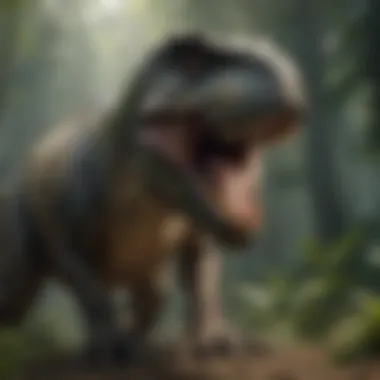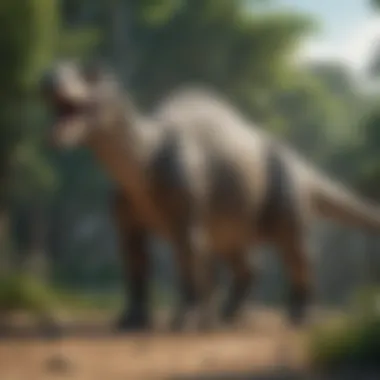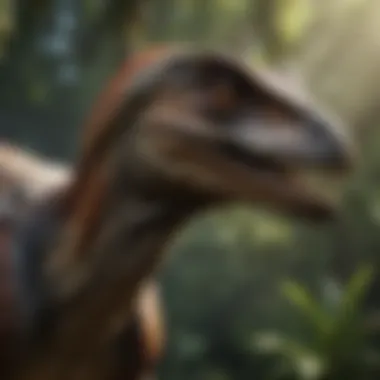Unraveling the Enigmatic Dinosaurs of Jurassic World: A Journey Through Time


Rock and Fossil Identification
Exploring the world of Jurassic World's dinosaurs begins with understanding the types of rocks and fossils that hold the key to unraveling their ancient existence. Each rock and fossil carries distinct characteristics that serve as clues to the prehistoric past. By examining these unique features, enthusiasts can uncover a wealth of information about the dinosaurs that once roamed the Earth. Utilizing specialized tools for identification enhances the exploration process, allowing collectors to unearth rare specimens with precision.
Collecting Tips and Techniques
To embark on a successful collecting journey, individuals must adhere to best practices that ensure the preservation and integrity of the rocks and fossils they discover. Locating prime collecting sites is paramount, as these locations hold the potential for significant findings. Employing safe extraction techniques is essential to avoid damage to specimens and ensure a fruitful collecting experience.
Preservation and Display
Preserving rocks and fossils is a delicate art that requires meticulous attention to detail. By employing techniques that inhibit degradation, collectors can safeguard these treasures for future generations to appreciate. Implementing proper storage methods is crucial in maintaining the quality of specimens over time. Additionally, exploring creative display ideas allows enthusiasts to showcase their collection in a visually compelling manner that captures the intrigue of Jurassic World's dinosaurs.
Geological Insights
Delving into the geological aspects of Jurassic World opens up a world of discovery and significance. By studying geological formations and processes, collectors gain profound insights into the environments that existed during the time of the dinosaurs. Exploring the historical significance of rocks and fossils sheds light on the evolutionary journey of life on Earth. Additionally, uncovering notable discoveries in the field unveils fascinating stories of paleontological feats that continue to shape our understanding of prehistoric beings.
Introduction
Exploring the Jurassic Era
The geological significance of the Jurassic period
Unveiling the intricate tapestry of the prehistoric world, the geological significance of the Jurassic period stands as a foundational aspect in understanding Earth's history. This section delves into the specific geological aspects that defined the Jurassic era, highlighting its contribution to the overall topic. By emphasizing key characteristics such as sedimentary formations and climate patterns, readers will grasp why the geological significance of the Jurassic period is a crucial element in unraveling the mysteries of ancient life. Furthermore, exploring the unique features of this period's geology provides valuable insights into the advantages it offers for a comprehensive discussion within this article.


Key features of the Jurassic landscape
Discovery of Jurassic World
Pioneering paleontological expeditions
Venturing into the untamed wilderness of scientific exploration, pioneering paleontological expeditions represent a hallmark of discovery in Jurassic World. This segment explores the daring quests of early paleontologists who unearthed the ancient secrets buried beneath layers of rock and time. By highlighting the grit and determination of these trailblazers, readers are transported back to an era of intellectual curiosity and brave discovery. The distinctive feature of these expeditions not only enriches the narrative of this article but also underscores their indispensable role in shaping our understanding of prehistory.
Unearthing fossilized remains
Delving into the ancient remnants of a bygone era, the process of unearthing fossilized remains reveals a treasure trove of information regarding Jurassic creatures. This section illuminates the meticulous work involved in excavating and preserving these fossilized vestiges, showcasing the dedication of paleontologists in piecing together the fragmented puzzles of the past. By emphasizing the key characteristics of fossil excavation and the insights gained from studying these remains, readers gain a profound appreciation for the significance and challenges inherent in unraveling the mysteries of ancient life forms.
Majestic Dinosaurs
In the vast tapestry of prehistoric life, the topic of Majestic Dinosaurs stands as a pillar of intrigue and scientific fascination within the realms of Jurassic World exploration. As we embark on this evolutionary journey, the significance of Majestic Dinosaurs unveils a diverse range of ancient creatures that once ruled the Earth. This section serves as a gateway to understanding the grandeur and complexity of these extraordinary beings, shedding light on their unique characteristics, behaviors, and ecological roles.
The Mighty Predators
Tyrannosaurus Rex: King of the dinosaurs
The majestic Tyrannosaurus Rex, synonymous with power and ferocity, reigns as a charismatic icon of the Jurassic era. Its colossal size, razor-sharp teeth, and unparalleled dominance in the prehistoric food chain make it a focal point of intrigue and wonder in paleontological studies. Unraveling the mysteries shrouding the lifestyle and hunting strategies of this apex predator adds a layer of depth to the narrative of Jurassic World's ecosystem. By delving into the distinctive features and evolutionary adaptations of the Tyrannosaurus Rex, we gain profound insights into its unparalleled role as a formidable hunter and ruler of its domain.
Velociraptors: Agile hunters of the Jurassic


As agile predators of the Jurassic landscape, Velociraptors embody cunning intellect and cooperative hunting tactics that set them apart as formidable hunters. Their keen senses, razor-sharp claws, and pack-oriented behavior present a compelling narrative of survival and adaptation in a harsh and unforgiving ancient world. Exploring the intricate social dynamics and territorial behaviors of Velociraptors offers a glimpse into the complexities of interspecies interactions and predatory strategies that shaped the ecological balance of Jurassic ecosystems.
Gentle Giants and Flying Wonders
Brachiosaurus: Towering herbivores
The towering Brachiosaurus, with its graceful neck and colossal presence, symbolizes the gentle giants of the Jurassic period. These herbivorous behemoths roamed the ancient landscapes, utilizing their elongated necks to reach towering foliage and sustain their massive frames. Examining the unique anatomical adaptations and feeding behaviors of Brachiosaurus sheds light on the challenges and advantages of being a large herbivore in a world teeming with competition and carnivorous threats, enriching our understanding of the diverse herbivorous guild within Jurassic World.
Pteranodons: Masters of the Jurassic skies
Taking to the skies with unparalleled grace and mastery, the Pteranodons represent the aerial wonders of the Jurassic era. These majestic flying reptiles, with their wingspan stretching across the azure heavens, navigated ancient skies with effortless elegance and precision. Studying the aerodynamic adaptations and flight behaviors of Pteranodons unravels the mysteries of Jurassic aerial ecosystems and the evolutionary innovations that allowed these creatures to conquer the skies, showcasing their remarkable adaptations in the context of prehistoric ecology and avian evolution.
Adaptations and Behaviors
Survival Tactics
Camouflage and Mimicry in Jurassic Creatures
Camouflage and mimicry in Jurassic creatures played a pivotal role in their quest for survival. This specific aspect enabled dinosaurs to blend seamlessly into their surroundings, evading predators or enhancing their hunting prowess. The key characteristic of camouflage and mimicry lies in its ability to provide a defensive mechanism, allowing dinosaurs to remain unnoticed or to mimic other species for various purposes. This adaptive trait was a favored choice for dinosaurs, as it allowed them to safeguard themselves from threats or to surprise their prey. The unique feature of camouflage and mimicry in Jurassic creatures was the way it could be tailored to different environments and circumstances, granting dinosaurs a strategic advantage. While advantageous in providing protection, camouflage and mimicry also had its disadvantages, such as the need for constant adaptation as environments changed, showcasing the dynamic nature of this survival tactic within the Jurassic world.
Pack Hunting Strategies
Another fundamental aspect within survival tactics was the utilization of pack hunting strategies among dinosaurs. This specific tactic contributed significantly to the overall success of hunting and securing resources for dinosaur communities. The key characteristic of pack hunting strategies revolved around communal efforts to bring down larger prey, thus increasing the chances of survival and ensuring a stable food supply. This approach was a popular choice for dinosaurs due to its efficiency in taking down bigger targets collectively. The unique feature of pack hunting strategies was the social intricacies that developed within dinosaur groups, showcasing coordination, communication, and division of labor for hunting purposes. While advantageous in securing sustenance, pack hunting strategies had its drawbacks, such as potential conflict within the group or competition for resources, laying bare the delicate balance in dinosaur communities.


Communication and Social Structure
Roars, Calls, and Displays
Communication through roars, calls, and displays played a crucial role in the interaction and social structure of dinosaur communities. This specific aspect allowed dinosaurs to convey various messages, such as territorial claims, warnings, or mating calls. The key characteristic of roars, calls, and displays was their multifunctional utility in shaping social dynamics and relationships within dinosaur populations. It was a beneficial choice for this article as it elucidates the importance of communication in understanding dinosaur behaviors and interactions. The unique feature of roars, calls, and displays was the distinct signals and cues that dinosaurs used to express emotions or intentions, fostering a deeper connection within the group. While advantageous in promoting cohesion, communication through roars, calls, and displays could have disadvantages, such as confusion in crowded environments or misinterpretation of signals, highlighting the complexity of social communication among dinosaurs.
Hierarchical Organization in Dinosaur Communities
The hierarchical organization in dinosaur communities was a vital factor in maintaining order and structure within groups. This specific aspect contributed to decision-making processes, resource allocation, and overall stability in dinosaur societies. The key characteristic of hierarchical organization resided in the establishment of dominance hierarchies, where certain individuals held higher status and authority. It was a popular choice for this article as it delves into the social dynamics and structures prevalent among dinosaurs. The unique feature of hierarchical organization was the clear division of roles and responsibilities based on status, ensuring efficient functioning within the community. While advantageous in promoting leadership and organization, hierarchical organization could pose disadvantages, such as potential conflicts for dominance or exclusion of certain group members, underscoring the intricacies of social hierarchies in dinosaur communities.
Paleontological Insights
Fossil Records and Reconstruction
Interpreting skeletal remains
Interpreting skeletal remains plays a crucial role in piecing together the puzzle of dinosaur existence. By examining fossils and skeletal remains, paleontologists can decipher crucial information about the physiology, behavior, and adaptations of ancient creatures. In this article, the focus on Interpreting skeletal remains sheds light on the methodologies used to extract valuable data from fossils. The key characteristic of this process lies in its ability to reconstruct the anatomical structures of dinosaurs, providing insights into their size, locomotion, and diet. The advantage of Interpreting skeletal remains in this article is its foundation in empirical evidence, allowing for a factual representation of dinosaurs that aligns with scientific principles. While the process may have limitations, such as missing pieces or fragmentary evidence, its significance in uncovering the true nature of dinosaurs cannot be overstated.
Reconstructing the appearance and behavior of dinosaurs
Reconstructing the appearance and behavior of dinosaurs fulfills a crucial role in reconstructing the past. By utilizing fossil evidence, scientific principles, and anatomical knowledge, paleontologists can create detailed reconstructions of extinct species. In the context of this article, the focus on reconstructing appearance and behavior offers a window into the Mesozoic era, painting a vivid picture of how dinosaurs looked and interacted within their ecosystems. The key characteristic of this process lies in its ability to merge scientific data with artistic interpretation, providing a holistic view of dinosaurs that resonates with researchers and enthusiasts alike. The advantage of reconstructing appearance and behavior in this article is its capacity to bridge the gap between scientific research and public engagement, fostering a deeper appreciation for prehistoric life. While interpretations may vary based on available evidence, the insights gained from these reconstructions offer invaluable contributions to our understanding of dinosaurs and their evolutionary journey.
Evolutionary Significance
Linking dinosaurs to modern-day species
Linking dinosaurs to modern-day species constitutes a fundamental aspect of evolutionary biology. By establishing connections between ancient and contemporary organisms, researchers can infer evolutionary relationships and trace the lineage of various taxa. In the confines of this article, the emphasis on linking dinosaurs to modern-day species illuminates the legacy of ancient reptiles and their impact on present-day biodiversity. The key characteristic of this approach lies in its ability to highlight evolutionary transitions and adaptations, showcasing the enduring legacy of dinosaurian traits in modern animals. The benefit of linking dinosaurs to modern-day species in this article is its capacity to bridge the temporal gap between past and present, offering insights into the shared ancestry and biological continuities that define life on Earth. While challenges may arise in linking disparate species, the evolutionary significance observed in this article underscores the enduring influence of dinosaurs on the world we inhabit.
Insights into the extinction of dinosaurs
Insights into the extinction of dinosaurs hold a paramount importance in unraveling one of the greatest mysteries in Earth's history. By investigating the factors that led to the demise of dinosaurs, researchers can glean valuable lessons about environmental change, catastrophic events, and species survival. In the scope of this article, the exploration of insights into the extinction of dinosaurs provides a platform for understanding the dynamics that shaped past mass extinctions. The key characteristic of this examination lies in its interdisciplinary nature, drawing upon geological, climatological, and biological evidence to piece together the puzzle of extinction events. The advantage of gaining insights into the extinction of dinosaurs in this article is its ability to shed light on the fragility of ecosystems, the resilience of life forms, and the transformative power of global events. While uncertainties may linger regarding the precise mechanisms of extinction, the insights generated from this exploration offer a profound perspective on the interconnectedness of life and the fragile balance that sustains it.







